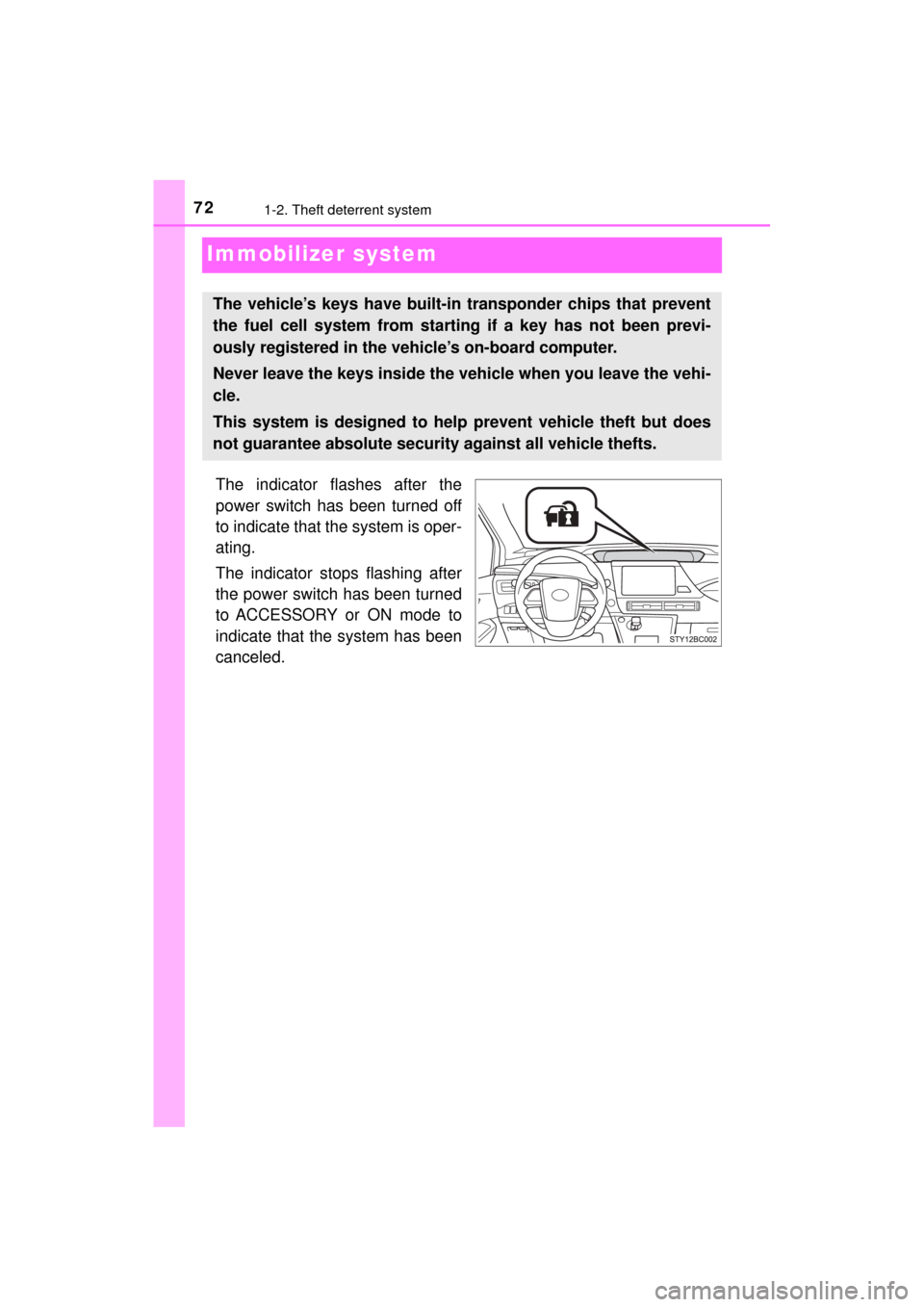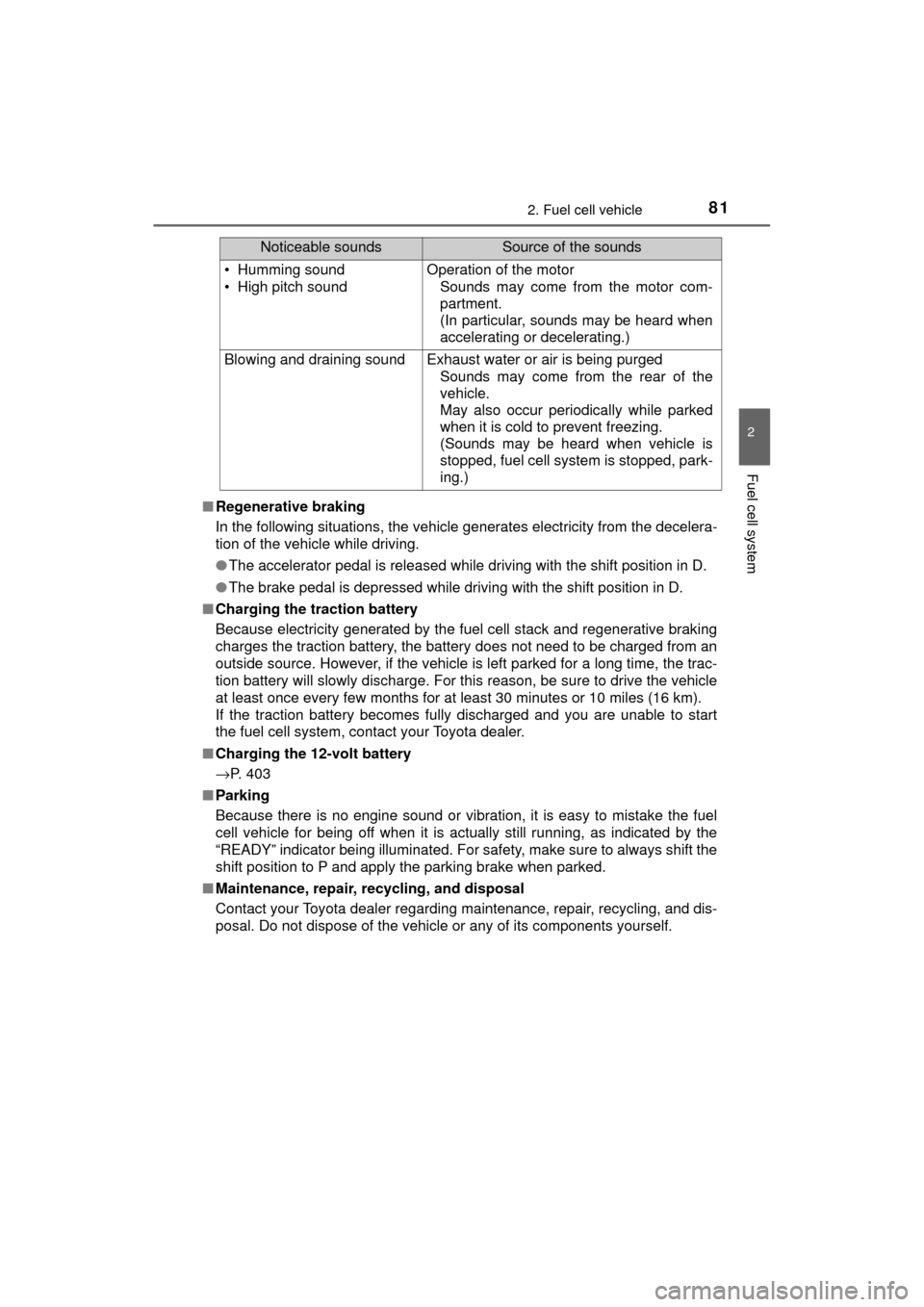2017 TOYOTA MIRAI stop start
[x] Cancel search: stop startPage 5 of 464

5
MIRAI_OM_USA_OM62023U
1
9 8 6 5
4
3
2
10
7
8-1. Essential informationEmergency flashers .......... 360
If your vehicle has to be stopped in an
emergency ...................... 361
8-2. Steps to take in an emergency
If your vehicle needs to be towed ......................... 362
If you think something is wrong .............................. 368
If a warning light turns on or a warning buzzer
sounds ............................ 369
If a warning message is displayed ......................... 376
If you have a flat tire .......... 381
If the fuel cell system will not start ........................... 396
If the electronic key does not operate properly ........ 398
If the 12-volt battery is discharged ...................... 401
If your vehicle overheats ........................ 406
If the vehicle becomes stuck................................ 412 9-1. Specifications
Maintenance data (fuel, fluid level, etc.) ....... 416
Tire information.................. 422
9-2. Customization Customizable features ....... 434
9-3. Items to initialize Items to initialize ................ 442
Reporting safety defects for U.S. owners ........................ 444
What to do if... (Troubleshooting) ..................... 446
Alphabetical index ...................... 449
8When trouble arises9Vehicle specifications
10For owners
Index
For information regarding the equipment listed below, refer to the
“NAVIGATION SYSTEM OWNER’S MANUAL”.
• Navigation system
• Audio system• Rear view monitor system
Page 16 of 464

16Pictorial index
MIRAI_OM_USA_OM62023U
■Instrument panel
Power switch . . . . . . . . . . . . . . . . . . . . . . . . . . . . . . . . . . . . . P. 172
Starting the fuel cell system/changing the modes . . . . . . . . . . P. 172
Emergency stop of the fuel cell system . . . . . . . . . . . . . . . . . . P. 361
When the fuel cell system will not start . . . . . . . . . . . . . . . . . . P. 396
Warning messages . . . . . . . . . . . . . . . . . . . . . . . . . . . . . . . . . P. 376
Shift lever . . . . . . . . . . . . . . . . . . . . . . . . . . . . . . . . . . . . . . . . P. 179
Changing the shift position . . . . . . . . . . . . . . . . . . . . . . . . . . . P. 179
Precautions against towing . . . . . . . . . . . . . . . . . . . . . . . . . . . P. 362
Meters . . . . . . . . . . . . . . . . . . . . . . . . . . . . . . . . . . . . . . . . . . . P. 102
Reading the meters/adjusting the meter light . . . . . . . . . . . . . P. 104
Warning lights/indicator lights . . . . . . . . . . . . . . . . . . . . . . . . . . P. 98
When the warning lights come on . . . . . . . . . . . . . . . . . . . . . . P. 369
Multi-information display . . . . . . . . . . . . . . . . . . . . . . . . . . . P. 107
Display . . . . . . . . . . . . . . . . . . . . . . . . . . . . . . . . . . . . . . . . . . . P. 107
Energy monitor . . . . . . . . . . . . . . . . . . . . . . . . . . . . . . . . . . . . P. 108
When a warning message or indicator is displayed . . . . . . . . . P. 376
Page 29 of 464

291-1. For safe use
1
For safety and security
MIRAI_OM_USA_OM62023U
WARNING
Observe the following precautions.
Failure to do so may result in death or serious injury.
●Do not adjust the position of the driver’s seat while driving.
Doing so could cause the driver to lose control of the vehicle.
● Do not place a cushion between the driver or passenger and the seatback.
A cushion may prevent correct posture from being achieved, and reduce
the effectiveness of the seat belt and head restraint.
● Do not place anything under the front seats.
Objects placed under the front seats may become jammed in the seat
tracks and stop the seat from locking in place. This may lead to an acci-
dent and the adjustment mechanism may also be damaged.
● Always observe the legal speed limit when driving on public roads.
● When driving over long distances, take regular breaks before you start to
feel tired.
Also, if you feel tired or sleepy while driving, do not force yourself to con-
tinue driving and take a break immediately.
Page 72 of 464

721-2. Theft deterrent system
MIRAI_OM_USA_OM62023U
Immobilizer system
The indicator flashes after the
power switch has been turned off
to indicate that the system is oper-
ating.
The indicator stops flashing after
the power switch has been turned
to ACCESSORY or ON mode to
indicate that the system has been
canceled.
The vehicle’s keys have built-in transponder chips that prevent
the fuel cell system from starting if a key has not been previ-
ously registered in the vehicle’s on-board computer.
Never leave the keys inside the vehicle when you leave the vehi-
cle.
This system is designed to help prevent vehicle theft but does
not guarantee absolute security against all vehicle thefts.
Page 74 of 464

741-2. Theft deterrent system
MIRAI_OM_USA_OM62023U
Alarm
The alarm uses light and sound to give an alert when an intrusion is
detected.
The alarm is triggered in the following situations when the alarm is
set:
●A locked door or trunk is unlocked or opened in any way other than
using the entry function, wireless remote control or mechanical key.
(The doors will lock again automatically.)
● The hood is opened.
Close the doors, trunk and hood,
and lock all the doors. The system
will be set automatically after 30
seconds.
The indicator changes from being
on to flashing when the system is
set.
Do one of the following to deactivate or stop the alarm:
● Unlock the doors or open the trunk.
● Turn the power switch to ACCESSORY or ON mode, or start the
fuel cell system. (The alarm will be deactivated or stopped after a
few seconds.)
The alarm
Setting the alarm system
Deactivating or stopping the alarm
Page 80 of 464

802. Fuel cell vehicle
MIRAI_OM_USA_OM62023U
■Sounds unique to the fuel cell vehicle
Due to the design of your fuel cell vehicle, there are various relays, valves
and pumps which under normal driving conditions will produce sounds. This
is a normal characteristic of the vehicle and does not indicate a malfunction.
Furthermore, way of hearing may differ based on usage environment or con-
dition.
Noticeable soundsSource of the sounds
Clunking, clicking and clack-
ingOperation of relays and hydrogen tank
valves
Sounds may come from under the floor or
behind the rear seats.
(Sounds may be heard when starting the
fuel cell system.)
KnockingThe parking lock is engaged
Sounds may come from the motor
compartment.
(Sounds may be heard when press the P
position switch or stopping the fuel cell
system.)
Whooshing, squealingGas is flowing through the nozzle and
valvesSounds may come from behind the rear
seats, or from the dispenser hose/nozzle.
(Sounds may be heard when filling the
fuel.)
• High pitch sound
• Gurgle sound
• Pulsing soundOperation of the pumpsSounds may come from the motor com-
partment or under the front seats.
(In particular, sounds may be heard when
starting the fuel cell system, accelerating
from a stop, or press the H
2O switch. The
sound may be louder when in Br mode or
when the vehicle decelerates during
dynamic radar cruise control.)
Humming soundOperation of the pumps are speeding up
Sounds may come from the motor com-
partment or under the front seats.
(In particular, sounds may be heard when
accelerating or decelerating.)
Whooshing sound Operation of the hydrogen injectorSounds may come from under the front
seats or behind the rear seats.
(In particular, sounds may be heard when
starting the fuel cell system, driving at low
speeds, or charging the traction battery.)
Page 81 of 464

812. Fuel cell vehicle
2
Fuel cell system
MIRAI_OM_USA_OM62023U■
Regenerative braking
In the following situations, the vehicle generates electricity from the decelera-
tion of the vehicle while driving.
●The accelerator pedal is released while driving with the shift position in D.
● The brake pedal is depressed while driving with the shift position in D.
■ Charging the traction battery
Because electricity generated by the fuel cell stack and regenerative braking
charges the traction battery, the battery does not need to be charged from an
outside source. However, if the vehicle is left parked for a long time, the trac-
tion battery will slowly discharge. For this reason, be sure to drive the vehicle
at least once every few months for at least 30 minutes or 10 miles (16 km).
If the traction battery becomes fully discharged and you are unable to start
the fuel cell system, contact your Toyota dealer.
■ Charging the 12-volt battery
→P. 403
■ Parking
Because there is no engine sound or vibration, it is easy to mistake the fuel
cell vehicle for being off when it is actually still running, as indicated by the
“READY” indicator being illuminated. For safety, make sure to always shift the
shift position to P and apply the parking brake when parked.
■ Maintenance, repair, recycling, and disposal
Contact your Toyota dealer regarding maintenance, repair, recycling, and dis-
posal. Do not dispose of the vehicle or any of its components yourself.
• Humming sound
• High pitch soundOperation of the motor
Sounds may come from the motor com-
partment.
(In particular, sounds may be heard when
accelerating or decelerating.)
Blowing and draining soundExhaust water or air is being purgedSounds may come from the rear of the
vehicle.
May also occur periodically while parked
when it is cold to prevent freezing.
(Sounds may be heard when vehicle is
stopped, fuel cell system is stopped, park-
ing.)
Noticeable soundsSource of the sounds
Page 84 of 464

842. Fuel cell vehicle
MIRAI_OM_USA_OM62023U
When a certain level of impact from an accident is detected, the fuel
cell system is shut down and the system shuts out the high voltage.
Also, the fuel supply is stopped from the hydrogen tank valves. If the
emergency shut off system activates, your vehicle will not restart. To
restart the fuel cell system, contact your Toyota dealer.
A message is automatically displa yed when a malfunction occurs in
the fuel cell system or an im proper operation is attempted.
If a warning message is shown on
the multi-information display, read
the message and follow the
instructions. ( →P. 376)
Fuel cell vehicles do not have engi ne sounds like gasoline vehicles.
Therefore, it makes an artificial no ise at low speeds to notify pedestri-
ans and nearby vehicles that it is approaching. The sound varies with
speed and will stop when the v ehicle exceeds approximately 15 mph
(25 km/h).
Emergency shut off system
Fuel cell warning message
Vehicle proximity notification system